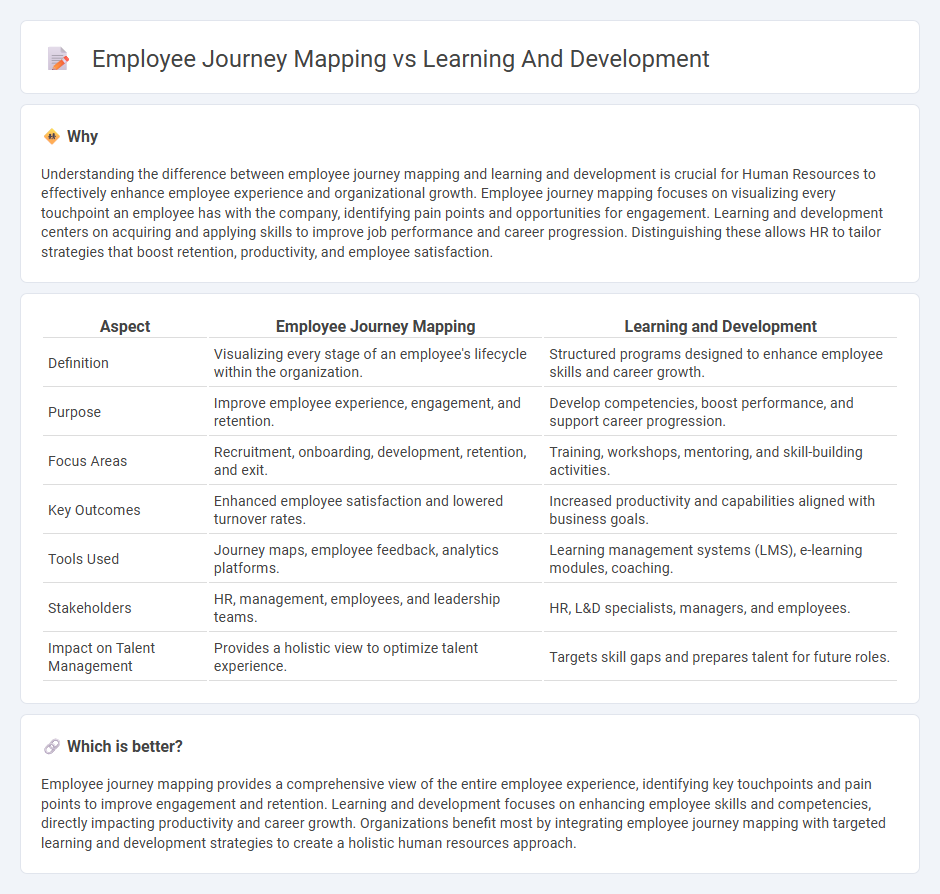
Employee journey mapping offers a comprehensive visualization of an employee's experience from recruitment to exit, highlighting key touchpoints and pain points within the organization. Learning and development focus on enhancing employees' skills and knowledge through targeted training programs to foster growth and improve performance. Explore how combining employee journey mapping with learning and development strategies can optimize workforce engagement and productivity.
Why it is important
Understanding the difference between employee journey mapping and learning and development is crucial for Human Resources to effectively enhance employee experience and organizational growth. Employee journey mapping focuses on visualizing every touchpoint an employee has with the company, identifying pain points and opportunities for engagement. Learning and development centers on acquiring and applying skills to improve job performance and career progression. Distinguishing these allows HR to tailor strategies that boost retention, productivity, and employee satisfaction.
Comparison Table
| Aspect | Employee Journey Mapping | Learning and Development |
|---|---|---|
| Definition | Visualizing every stage of an employee's lifecycle within the organization. | Structured programs designed to enhance employee skills and career growth. |
| Purpose | Improve employee experience, engagement, and retention. | Develop competencies, boost performance, and support career progression. |
| Focus Areas | Recruitment, onboarding, development, retention, and exit. | Training, workshops, mentoring, and skill-building activities. |
| Key Outcomes | Enhanced employee satisfaction and lowered turnover rates. | Increased productivity and capabilities aligned with business goals. |
| Tools Used | Journey maps, employee feedback, analytics platforms. | Learning management systems (LMS), e-learning modules, coaching. |
| Stakeholders | HR, management, employees, and leadership teams. | HR, L&D specialists, managers, and employees. |
| Impact on Talent Management | Provides a holistic view to optimize talent experience. | Targets skill gaps and prepares talent for future roles. |
Which is better?
Employee journey mapping provides a comprehensive view of the entire employee experience, identifying key touchpoints and pain points to improve engagement and retention. Learning and development focuses on enhancing employee skills and competencies, directly impacting productivity and career growth. Organizations benefit most by integrating employee journey mapping with targeted learning and development strategies to create a holistic human resources approach.
Connection
Employee journey mapping identifies critical touchpoints in the workforce lifecycle, enabling targeted learning and development initiatives that enhance skill acquisition and engagement. By analyzing each stage from onboarding to advancement, organizations tailor training programs to address specific needs and performance gaps. This strategic alignment boosts retention rates and accelerates employee growth within the company.
Key Terms
**Learning and Development:**
Learning and Development (L&D) focuses on enhancing employee skills, knowledge, and performance through targeted training programs, workshops, and continuous education initiatives. It plays a critical role in fostering career growth, increasing job satisfaction, and driving organizational productivity by aligning learning objectives with business goals. Discover how effective L&D strategies can transform workforce capabilities and contribute to long-term success.
Training Programs
Learning and development centers on designing training programs to enhance employee skills, performance, and career growth, emphasizing measurable outcomes like knowledge retention and productivity improvement. Employee journey mapping involves analyzing the entire work experience, identifying touchpoints where training can address skill gaps, engagement, and job satisfaction to drive holistic development. Explore how integrating both approaches can optimize training strategies and improve overall employee success.
Skill Gap Analysis
Skill gap analysis is crucial in both learning and development and employee journey mapping, pinpointing specific competencies employees lack to enhance performance. While learning and development uses this analysis to tailor training programs for closing skill gaps, employee journey mapping applies it to identify pain points and growth opportunities throughout an employee's lifecycle. Explore how integrating skill gap analysis in these strategies can revolutionize workforce capability and engagement.
Source and External Links
Learning and Development: A Comprehensive Guide - AIHR - Learning and development (L&D) is a systematic process to enhance employees' skills and knowledge to improve work performance and support long-term growth through both learning activities and developmental opportunities like leadership training and mentoring.
Learning and Development Importance [Updated 2025] - Kaltura - L&D aligns employee goals with organizational objectives by identifying skill gaps, delivering tailored training, optimizing learning processes, and leveraging technology to improve performance and foster cohesive company culture.
What is Learning and Development? - TD.org - L&D is an organizational function empowering employees' growth with programs ranging from onboarding to leadership development, aligning learning strategy with business goals to drive workforce capability and business results.
 dowidth.com
dowidth.com